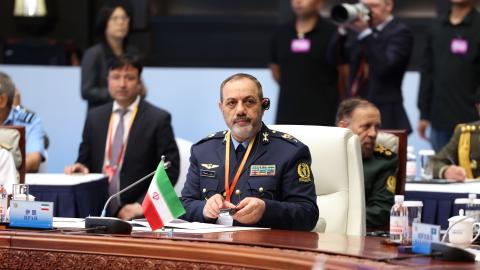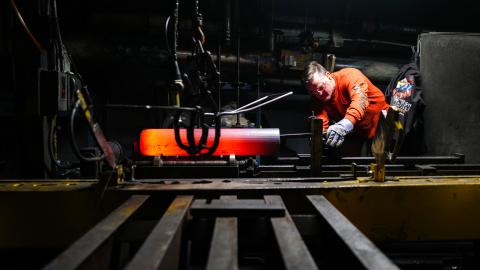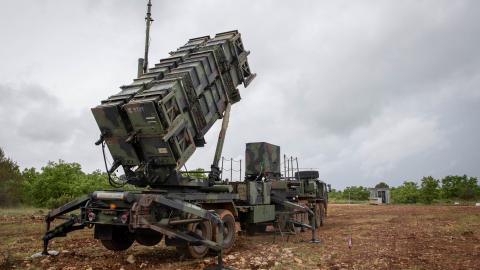Missiles have become the weapon of choice for many hostile regimes, making it impossible to credibly argue that the U.S. does not need a missile defense system. Even so, no one in Washington can argue that America’s ballistic missile defenses are as capable as we would like them to be. While current capabilities are very good, they are still not good enough. Systems have not been tested as often as they needs to be, and promising ones have been cancelled. Meanwhile, the demand from military leaders for more interceptors has been met with shortfalls. As for America’s allies, they seek greater cooperation on missile defense, yet a number of important opportunities have been cancelled.
The good news surrounding missile defense today is also the bad news. The hurdles impeding greater success for our efforts are largely political in nature. This means that the problems are entirely solvable, but require a large measure of prudence and determination. It also means that supporters of missile defense must push for ambitious yet achievable objectives to improve the system in the near term, even as they keep in mind a long-term agenda of adaptable, survivable systems that utilize all domains and target missiles in all phases of flight.
THE LONG VIEW
If America’s current missile defense system is to mature sufficiently to the point where it is useful in the future, the U.S. must end its policy of defending against only rogue state missile attack, and develop and deploy boost-phase defense (including space based interceptors, or SBI).
The Missile Defense Agency (MDA) follows the guidance found in the Missile Defense Act of 1999 (P.L. 106-38), which states that “It is the policy of the United States to deploy as soon as is technologically possible an effective National Missile Defense system capable of defending the territory of the United States against limited ballistic missile attack (whether accidental, unauthorized, or deliberate)…” The key word “limited” means the U.S. is not developing a system designed to handle the kinds of missile assaults that countries like Russia or China are capable of launching.
This policy of limited protection has been reinforced ad nauseam in diplomatic conversations. For example, in 2012, when China expressed its objection to the U.S. deployment of an Aegis radar to Japan, then-Secretary of Defense Robert Gates spent quite a bit of energy trying to allay Chinese concerns that U.S-Japanese missile defense plans would diminish Beijing’s offensive threat to the U.S. and Japan. This has been the American modus operandi in dealing with Russian objections as well. The Bush administration tried, without success, to convince the Russians that its plans to deploy powerful long-range interceptors and radars in Poland and the Czech Republic, respectively, would not and could not weaken Russian offensive missile threats to U.S. allies or the U.S. homeland. The Obama administration has continued trying, and failing, to allay Russian concerns regarding U.S. missile defense plans to deploy SM-3 interceptors in Eastern Europe.
None of the existing plans to deploy missile defense systems in Europe or the U.S. have the ability to protect against Russian or Chinese missile attack. The problem is not that the Russians and Chinese don’t believe this; rather, it is that the U.S. continues to entertain Moscow and Beijing’s arguments that they have some sort of right to hold the U.S. and our allies at risk of nuclear attack.
By continuing to concede the argument that there is a threshold at which U.S. missile defense systems become provocative—and by purposefully limiting our system to only defend against the most primitive of missile threats—the U.S. is still functioning under the policy of Mutually Assured Destruction (MAD). Implicit in this notion is the fallacy that, should the U.S. develop missile defenses to the point that it diminishes Russian or Chinese offensive nuclear weapons, it would threaten global stability. The solution—maintaining peace by allowing Moscow and Beijing to hold the American population at risk of nuclear attack—is both foolish and immoral.
Recent events make future conflict a plausible scenario. Senior Russian officials have made threats to employ nuclear weapons against the U.S. or our allies more than a dozen times since 2008. Former undersecretary of defense Michele Flournoy, note that, “If you read recent Russian military doctrine… they are actually increasing their reliance on nuclear weapons, the role of nuclear weapons in their strategy.”1 Meanwhile, China’s opaqueness surrounding its missile and nuclear programs, combined with what we do know about its emphasis on strategic weaponry, should also give policymakers a healthy amount of skepticism regarding China’s “peaceful rise.” Under Secretary of Defense James Miller put it this way: “the lack of transparency surrounding China’s nuclear programs— their pace and scope, as well as the strategy and doctrine that guide them—raise questions about China’s future strategic intentions.”2
By limiting our capabilities in an effort to acquiesce to Russian and Chinese demands, we have also limited the system against other threats. Even though Iran and North Korea do not currently have the capability to launch long-range attacks against the U.S., they soon could. In fact, some in the intelligence community believe North Korea already has reached that ability, despite its frequent failed test launches. If this is true, one can deduce it will not take long for Iran to have the ability as well, since the two countries have collaborated in depth on their missile programs. And if Tehran and Pyongyang master the technology to deliver long-range missiles, one can surmise they will work toward mastering the technology to deliver missiles with decoys and counter-measures.
These current and emerging threats require a robust defensive capability. The boost phase of a missile’s flight is the ideal time to intercept it because the offensive missile would have yet to deploy decoys or countermeasures. Currently, however, the U.S. has no mature boost phase system to speak of. Although other boost phase programs could be worth supporting, even if just to develop a program of record, having interceptors in space would give the U.S. the most cost-effective solution for intercepting in the boost phase.
A number of studies, including a February 2011 report by the Institute for Defense Analyses (IDA), have affirmed that currently available technology has reached a sufficient level of maturity for space-based intercepts. Deploying SBI, however, still remains almost if not entirely impossible in the current political environment. This is due to a White House and Senate hostile toward U.S. space weaponry, or for that matter any missile defense system that gives the U.S. a great strategic advantage, and a Republican controlled House that lacks agreement on national priorities.
Consequently, missile defense supporters should work now to stave off bad initiatives that, if implemented, would make it more difficult for wiser future administrations and Congresses to deploy SBI. One such bad initiative is a Code of Conduct for Outer Space, or any other iteration of an arms control agreement that would place limits on U.S. missile defenses. Missile defense supporters, while keeping this “long view agenda” in mind, should also proactively discuss the merits and wisdom of developing boost phase defenses, including SBI, and in breaking away from the policy of MAD in order to rally the American people and their representatives behind such initiatives.
NEAR TERM PRIORITIES
Although the current political environment is not conducive to deploying the most robust missile defense system technically possible, we can and should build on the system we have. Toward this end, there are five major, near-term and politically achievable concrete objectives for missile defense.
First, Congress must mitigate the effects of sequester. Current budgetary levels are not sustainable after this year, and the Missile Defense Agency (MDA) budget is not enough to deliver what the Ballistic Missile Defense Review (BMDR) lays out as the national priorities, nor is it enough to implement the MDA director’s objectives for the next couple of years. The bipartisan budget deal negotiated by Republican Congressman Paul Ryan and Democratic Senator Patty Murray in December relieved pressure on the Pentagon for FY14 and FY15. It does not, however, affect the automatic and indiscriminate defense cuts for the years beyond that.
For some context, the congressionally authorized MDA budget for the current year hovers around $7.7 billion. This is close to what it was for FY13, but far lower than what the Bush administration had planned to spend for the year: around $9.8 billion for FY13. Indeed, the MDA budget can be considered to have been underfunded every year that President Obama has been in office. Members of Congress who generally support missile defense, meanwhile, have started to accept that sequester can’t be helped—and as a result have looked to the MDA budget to cut one program to pay for another. Some expect the MDA budget to drop below $7 billion in FY15. This is unacceptable; supporters must insist that the MDA budget sees real increases, and should not tolerate such disastrously low figures.
Second, the U.S. must fill the gaps in the homeland defense piece of BMDS. The Ground-based Midcourse Defense (GMD) system has experienced problems with its various elements. These are technically fixable, but Republicans and Democrats must work together to see the program succeed by allowing it to experience more frequent tests, even if those tests entail missed intercepts. Moreover, the system must receive the funding necessary not only for sustainment but also for modernization.
Congress has mandated that the Pentagon examine possibilities for a third homeland defense site on the East Coast of the U.S. This would greatly enhance the coverage provided by the GMD system by giving operators another location and angle to shoot at incoming missiles. The Bush administration recognized the need for such a third site, as the Obama administration did initially, and devised a plan to deploy a new missile interceptor site in Poland. But the Obama White House since has cancelled both plans, and so the third site must finally move from a “plan” to a reality.
Third, the U.S. must fulfill its commitments to U.S. allies. Obama administration officials have repeatedly tried to assure the Romanians and the Poles that the U.S. commitment to deploy SM-3 missiles on their territories by 2016 and 2018, respectively, is “ironclad.” Yet, despite such public promises, the White House will be tempted to abandon these commitments in an effort to appease Russia—in much the same way it cancelled plans in to deploy GMD in Poland in 2009, and subsequently tabled plans to deploy the SM-3 IIB missile there in 2013. The U.S. must hold firm to its commitments, begin site development, and the Congress must work to provide the necessary funding for deployment.
Fourth, policymakers should devise a strategy for building on regional missile defense architectures in Asia and the Middle East. Secretary of Defense Chuck Hagel announced in December 2013 that the U.S. plans to cooperate with the GCC on missile defense.3 This is a positive step, and policymakers should support this initiative. In Asia, South Korea and Japan are already receiving missile defense assets and support from the U.S, but more should be done along those lines. For example, South Korea has the very capable PAC-2 system and is looking at several programs to boost its defensive posture, one of which is the Arrow system. This makes sense, considering Seoul has two Green Pine radars, the same radars supporting the Arrow system already deployed in Israel. Press reports indicate4 Seoul is hesitant to deploy more robust systems like Arrow out of a fear of China’s objections, despite the reality that China is building its own missile defense systems. Policy-makers must encourage these timely improvements, which would significantly bolster South Korea’s defensive posture and increase regional stability.
Finally, the U.S. must deny Russia and China the ability to coerce us and our allies regarding missile defense deployments. Although a U.S. policy to develop defenses with the ability to intercept Chinese and Russian missiles might not be in the cards in the near future, it is unacceptable to allow Moscow and Beijing to dictate what we can and cannot deploy to defend against current limited threats. Additionally, the U.S. must never provide sensitive missile defense technology to either country in an effort to appease them. The recently passed National Defense Authorization Act (NDAA) is proof that there is bipartisan consensus on the subject. Sections 1246 and 1251 of the NDAA outline Congress’ commitment to ensuring the Executive Branch not share sensitive missile defense technology including “hit to kill” and telemetry data with the Russian Federation, and prohibiting any cooperation with the Russians that could result in the limiting of U.S. or NATO missile defenses. Congress should continue putting this kind of pressure on the Executive Branch, and followup on related Congressionally-mandated reporting requirements to hold the White House accountable.
AN IMPERATIVE FOR PROGRESS
Today’s political and fiscal realities make improving the America’s ballistic missile defense system challenging. The U.S. must build on the great work that has already been accomplished, both politically and technically, if it is to guarantee the freedom to pursue its own interests and security, rather than resign itself to a world in which hostile regimes have the ability to blackmail and coerce the U.S. with nuclear armed ballistic missiles.”
















